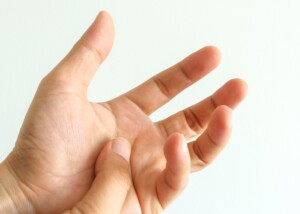
Have you discovered that the area below your knee is numb yet there’s no pain when you exercise or press it? Should you worry?
Cancer of the shin bone might occur to you if you’re prone to health anxiety.
What level of health anxiety you develop, upon discovering the area just under your knee feels numb, also depends on whether or not you’ve recently read content about cancer in the leg.
I accidentally discovered that the area below my knee, right where it seems to turn into the shin bones, was numb when I had my thumbs on the area to pull up my leg for a stretch.
Just three days prior – and so very ironically – I had published a guest-author article titled, “Runner’s Lower Leg Pain Below Knee Was a Missed Cancer.”
The author, Ann Graham, had been diagnosed with osteosarcoma at 43 – a cancer – of the tibia, one of the shin bones.
So that’s one of the first things I thought of upon discovering that the area below my knee felt partially numb.
There was no pain, though. No pain when I did any of the following: deep bodyweight and weighted squat, leg press, leg curl, leg extension, rapid chair squat holding dumbbell, jumping jacks, jumping from an exercise stool, trotting up and down stairs, incline walking, brisk level walking, jogging and kicking a heavy bag.
So I was resigned to just waiting to see what could unfold over the next several weeks.
The longer time went on without pain, the more reassured I was that it wasn’t anything serious including a hairline fracture of the tibia.
I googled the symptoms of a hairline fracture of the tibia as well as osteosarcoma of this bone – fearing that “numbness” would come up for the latter.
Thank goodness, though, that numbness or paresthesia is NOT a symptom of osteosarcoma, according to multiple major medical sites.
Numbness is vaguely inferred to be a possible symptom of a hairline fracture, but the information I came upon is ambiguous and not precise enough to draw a conclusion specific to the area just below the knee.
I also ruled out compression trauma, such as kneeling during yoga, because after stopping that, the numbness persisted.
Over a few months or so, the numbness began taking up a smaller space, so that the “epicenter” of the numbness was no longer numb. But the other areas were still kind of numb.
Then, several months into this, I began feeling an odd sensation when I jogged or walked briskly on a treadmill, as though masking tape was across the area.
I also felt this odd sensation every so often while seated, if that knee was really bent.
I began suspecting patellar tendonitis.

Patellar tendonitis. InjuryMap, CC BY-SA 4.0/creativecommons.org
During this entire time I had avoided doing heavy leg presses to help the inflammation of my iliopsoas tendon in the other leg calm down.
When I deemed it safe to return to heavy loads, I felt that odd sensation where the numbness was, kind of like a soreness.
I then got on the leg extension machine, and doggone it, felt soreness there. I stopped.
For the rest of the entire day, the area below my knee was noticeably sore.
From that point forward I avoided heavy leg presses, and did only light leg extensions. I also stopped jogging and briskly walking on the treadmill because that was kicking it up a little.
Eventually, any sensation of odd soreness or discomfort disappeared, and the numbness began to diminish even more.
So I then resumed jogging, and the numbness returned, but there was no discomfort.
Six and a half months after discovering the numb feeling under my knee, I saw a sports medicine doctor.
He confirmed my suspicion: patellar tendonitis.
I asked why this was causing the peculiar numbness.
He said it was likely due to the genicular nerve getting irritated, but he wasn’t able to explain just how patellar tendonitis could lead to this – even after I proposed a theory that the inflammation was “buzzing a nearby nerve and radiating the numbness.”
He said that damaged nerves grow back “a thousandth of a millimeter per day.” Perhaps he was exaggerating, but nerves do grow extremely slowly when in repair mode.
The doctor said that if pain develops, to stop the offending activity, and that seeing a physical therapist is always an option.
Right now I’m holding off on the one activity that he feels, as well as I, may have been the primary cause: jumping onto a hard floor from an exercise stool. He said that jumping can definitely cause patellar tendonitis, even though a ton of jumping jacks do not aggravate the condition for me.
So there you have it: a very likely cause for numbness under your knee but no pain – and also if some sort of discomfort eventually arises.
If severe pain begins developing that interferes with basic activity or even your toughest workouts, do not put off seeing a physician.


























